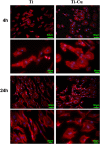Antibacterial effect of copper-bearing titanium alloy (Ti-Cu) against Streptococcus mutans and Porphyromonas gingivalis
- PMID: 27457788
- PMCID: PMC4960589
- DOI: 10.1038/srep29985
Antibacterial effect of copper-bearing titanium alloy (Ti-Cu) against Streptococcus mutans and Porphyromonas gingivalis
Abstract
Formation of bacterial biofilms on dental implant material surfaces (titanium) may lead to the development of peri-implant diseases influencing the long term success of dental implants. In this study, a novel Cu-bearing titanium alloy (Ti-Cu) was designed and fabricated in order to efficiently kill bacteria and discourage formation of biofilms, and then inhibit bacterial infection and prevent implant failure, in comparison with pure Ti. Results from biofilm based gene expression studies, biofilm growth observation, bacterial viability measurements and morphological examination of bacteria, revealed antimicrobial/antibiofilm activities of Ti-Cu alloy against the oral specific bacterial species, Streptococcus mutans and Porphyromonas gingivalis. Proliferation and adhesion assays with mesenchymal stem cells, and measurement of the mean daily amount of Cu ion release demonstrated Ti-Cu alloy to be biocompatible. In conclusion, Ti-Cu alloy is a promising dental implant material with antimicrobial/antibiofilm activities and acceptable biocompatibility.
Figures







Similar articles
-
In vitro and in vivo studies of anti-bacterial copper-bearing titanium alloy for dental application.Dent Mater. 2018 Aug;34(8):1112-1126. doi: 10.1016/j.dental.2018.04.007. Epub 2018 Apr 27. Dent Mater. 2018. PMID: 29709241
-
Repurposing Toremifene for Treatment of Oral Bacterial Infections.Antimicrob Agents Chemother. 2017 Feb 23;61(3):e01846-16. doi: 10.1128/AAC.01846-16. Print 2017 Mar. Antimicrob Agents Chemother. 2017. PMID: 27993858 Free PMC article.
-
The anti-bacterial activity of titanium-copper sintered alloy against Porphyromonas gingivalis in vitro.Dent Mater J. 2016;35(4):659-67. doi: 10.4012/dmj.2016-001. Dent Mater J. 2016. PMID: 27477233
-
In vitro assessment of stainless steel orthodontic brackets coated with titanium oxide mixed Ag for anti-adherent and antibacterial properties against Streptococcus mutans and Porphyromonas gingivalis.Microb Pathog. 2017 Nov;112:190-194. doi: 10.1016/j.micpath.2017.09.052. Epub 2017 Sep 29. Microb Pathog. 2017. PMID: 28966064
-
An Antibacterial Strategy of Mg-Cu Bone Grafting in Infection-Mediated Periodontics.Biomed Res Int. 2020 Aug 28;2020:7289208. doi: 10.1155/2020/7289208. eCollection 2020. Biomed Res Int. 2020. PMID: 32908908 Free PMC article.
Cited by
-
Promoting osteointegration effect of Cu-alloyed titanium in ovariectomized rats.Regen Biomater. 2022 Feb 24;9:rbac011. doi: 10.1093/rb/rbac011. eCollection 2022. Regen Biomater. 2022. PMID: 35480856 Free PMC article.
-
Anti-biofilm Activities from Bergenia crassifolia Leaves against Streptococcus mutans.Front Microbiol. 2017 Sep 13;8:1738. doi: 10.3389/fmicb.2017.01738. eCollection 2017. Front Microbiol. 2017. PMID: 28955316 Free PMC article.
-
Anti-Bacterial Properties and Biocompatibility of Novel SiC Coating for Dental Ceramic.J Funct Biomater. 2020 May 20;11(2):33. doi: 10.3390/jfb11020033. J Funct Biomater. 2020. PMID: 32443691 Free PMC article.
-
Advances in copper-containing biomaterials for managing bone-related diseases.Regen Biomater. 2025 Mar 18;12:rbaf014. doi: 10.1093/rb/rbaf014. eCollection 2025. Regen Biomater. 2025. PMID: 40259976 Free PMC article. Review.
-
Transcriptional modulation of Porphyromonas gingivalis biofilms on titanium-copper implant surfaces.Folia Microbiol (Praha). 2025 Feb 15. doi: 10.1007/s12223-025-01246-8. Online ahead of print. Folia Microbiol (Praha). 2025. PMID: 39955444
References
-
- Kong L. et al. Theaflavins inhibits pathogenic properties of P. gingivalis and MMPs production in P. gingivalis-stimulated human gingival fibroblasts. Arch. Oral Biol. 60, 12–22 (2014). - PubMed
-
- Takeda O. et al. Ameliorating effects of Juzentaihoto on restraint stress and P. gingivalis-induced alveolar bone loss. Arch. Oral Biol. 59, 1130–1138 (2014). - PubMed
-
- Hardes J. et al. Lack of toxicological side-effects in silver-coated megaprostheses in humans. Biomaterials 28, 2869–2875 (2007). - PubMed
Publication types
MeSH terms
Substances
Grants and funding
LinkOut - more resources
Full Text Sources
Other Literature Sources
Medical
Molecular Biology Databases

